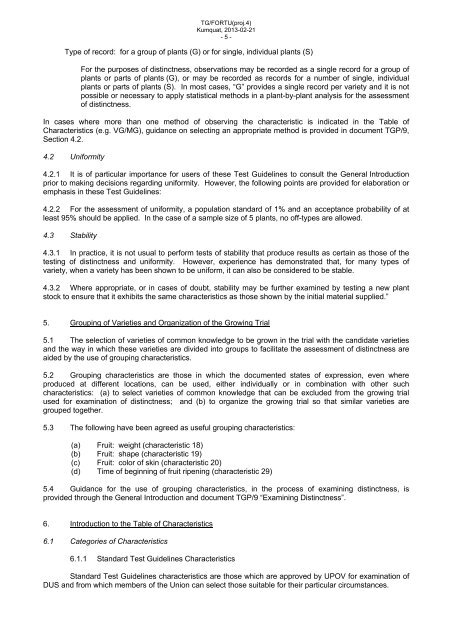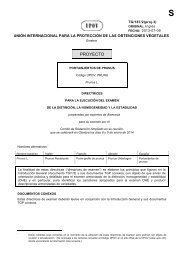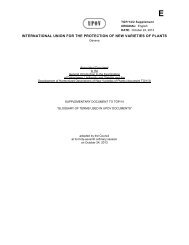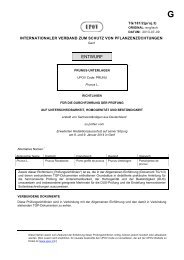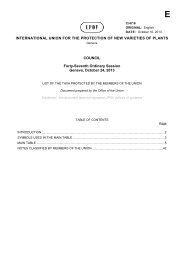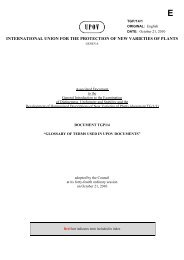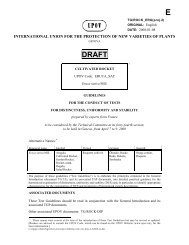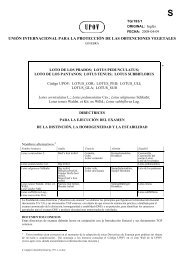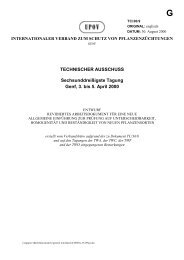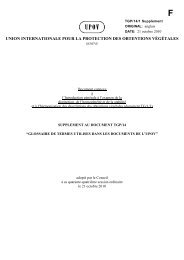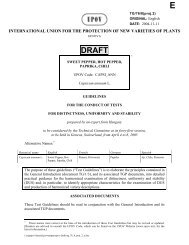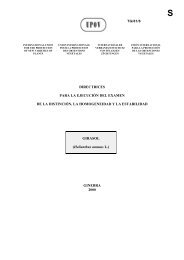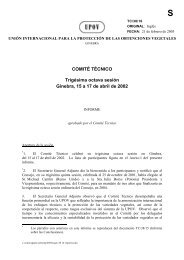Kumquat - International Union for the Protection of New Varieties of ...
Kumquat - International Union for the Protection of New Varieties of ...
Kumquat - International Union for the Protection of New Varieties of ...
Create successful ePaper yourself
Turn your PDF publications into a flip-book with our unique Google optimized e-Paper software.
TG/FORTU(proj.4)<br />
<strong>Kumquat</strong>, 2013-02-21<br />
- 5 -<br />
Type <strong>of</strong> record: <strong>for</strong> a group <strong>of</strong> plants (G) or <strong>for</strong> single, individual plants (S)<br />
For <strong>the</strong> purposes <strong>of</strong> distinctness, observations may be recorded as a single record <strong>for</strong> a group <strong>of</strong><br />
plants or parts <strong>of</strong> plants (G), or may be recorded as records <strong>for</strong> a number <strong>of</strong> single, individual<br />
plants or parts <strong>of</strong> plants (S). In most cases, “G” provides a single record per variety and it is not<br />
possible or necessary to apply statistical methods in a plant-by-plant analysis <strong>for</strong> <strong>the</strong> assessment<br />
<strong>of</strong> distinctness.<br />
In cases where more than one method <strong>of</strong> observing <strong>the</strong> characteristic is indicated in <strong>the</strong> Table <strong>of</strong><br />
Characteristics (e.g. VG/MG), guidance on selecting an appropriate method is provided in document TGP/9,<br />
Section 4.2.<br />
4.2 Uni<strong>for</strong>mity<br />
4.2.1 It is <strong>of</strong> particular importance <strong>for</strong> users <strong>of</strong> <strong>the</strong>se Test Guidelines to consult <strong>the</strong> General Introduction<br />
prior to making decisions regarding uni<strong>for</strong>mity. However, <strong>the</strong> following points are provided <strong>for</strong> elaboration or<br />
emphasis in <strong>the</strong>se Test Guidelines:<br />
4.2.2 For <strong>the</strong> assessment <strong>of</strong> uni<strong>for</strong>mity, a population standard <strong>of</strong> 1% and an acceptance probability <strong>of</strong> at<br />
least 95% should be applied. In <strong>the</strong> case <strong>of</strong> a sample size <strong>of</strong> 5 plants, no <strong>of</strong>f-types are allowed.<br />
4.3 Stability<br />
4.3.1 In practice, it is not usual to per<strong>for</strong>m tests <strong>of</strong> stability that produce results as certain as those <strong>of</strong> <strong>the</strong><br />
testing <strong>of</strong> distinctness and uni<strong>for</strong>mity. However, experience has demonstrated that, <strong>for</strong> many types <strong>of</strong><br />
variety, when a variety has been shown to be uni<strong>for</strong>m, it can also be considered to be stable.<br />
4.3.2 Where appropriate, or in cases <strong>of</strong> doubt, stability may be fur<strong>the</strong>r examined by testing a new plant<br />
stock to ensure that it exhibits <strong>the</strong> same characteristics as those shown by <strong>the</strong> initial material supplied.”<br />
5. Grouping <strong>of</strong> <strong>Varieties</strong> and Organization <strong>of</strong> <strong>the</strong> Growing Trial<br />
5.1 The selection <strong>of</strong> varieties <strong>of</strong> common knowledge to be grown in <strong>the</strong> trial with <strong>the</strong> candidate varieties<br />
and <strong>the</strong> way in which <strong>the</strong>se varieties are divided into groups to facilitate <strong>the</strong> assessment <strong>of</strong> distinctness are<br />
aided by <strong>the</strong> use <strong>of</strong> grouping characteristics.<br />
5.2 Grouping characteristics are those in which <strong>the</strong> documented states <strong>of</strong> expression, even where<br />
produced at different locations, can be used, ei<strong>the</strong>r individually or in combination with o<strong>the</strong>r such<br />
characteristics: (a) to select varieties <strong>of</strong> common knowledge that can be excluded from <strong>the</strong> growing trial<br />
used <strong>for</strong> examination <strong>of</strong> distinctness; and (b) to organize <strong>the</strong> growing trial so that similar varieties are<br />
grouped toge<strong>the</strong>r.<br />
5.3 The following have been agreed as useful grouping characteristics:<br />
(a) Fruit: weight (characteristic 18)<br />
(b) Fruit: shape (characteristic 19)<br />
(c) Fruit: color <strong>of</strong> skin (characteristic 20)<br />
(d) Time <strong>of</strong> beginning <strong>of</strong> fruit ripening (characteristic 29)<br />
5.4 Guidance <strong>for</strong> <strong>the</strong> use <strong>of</strong> grouping characteristics, in <strong>the</strong> process <strong>of</strong> examining distinctness, is<br />
provided through <strong>the</strong> General Introduction and document TGP/9 “Examining Distinctness”.<br />
6. Introduction to <strong>the</strong> Table <strong>of</strong> Characteristics<br />
6.1 Categories <strong>of</strong> Characteristics<br />
6.1.1 Standard Test Guidelines Characteristics<br />
Standard Test Guidelines characteristics are those which are approved by UPOV <strong>for</strong> examination <strong>of</strong><br />
DUS and from which members <strong>of</strong> <strong>the</strong> <strong>Union</strong> can select those suitable <strong>for</strong> <strong>the</strong>ir particular circumstances.


